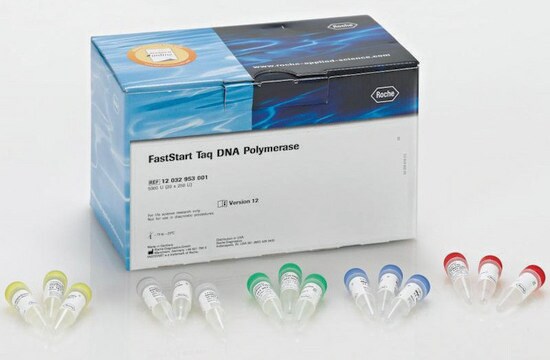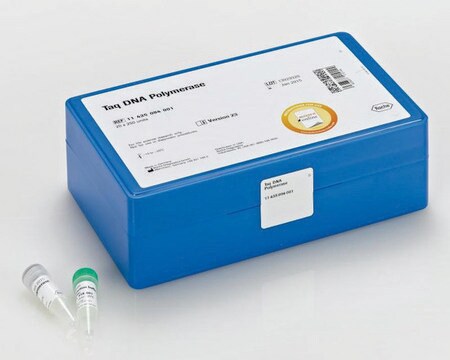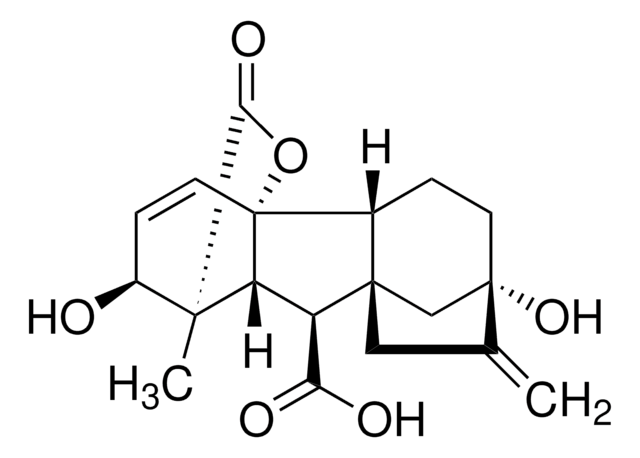推荐产品
儲存期限
≤18 mo.
品質等級
特點
dNTPs included: no
hotstart: no
包裝
pkg of 250 U (KK1014)
pkg of 2500 U (BK1000)
pkg of 500 U (KK1015)
pkg of 5000 U (BK1002)
製造商/商標名
Roche
技術
PCR: suitable
輸入
purified DNA
儲存溫度
−20°C
正在寻找类似产品? 访问 产品对比指南
應用
KAPA Taq PCR试剂盒已用于:
- 高通量 PCR
- 扩增低拷贝 DNA 模板
- 多重 PCR
- 复杂模板的特异性扩增
- RT-PCR
- 随机扩增多态性 DNA 聚合酶链反应 (RAPD-PCR)
- 聚合酶链式反应(PCR)
- 基因分型
生化/生理作用
KAPA Taq PCR试剂盒含有KAPA Taq DNA聚合酶,其由嗜热菌水生栖热菌的单亚基、野生型Taq DNA聚合酶改造而成。KAPA Taq和KAPA Taq HotStart® DNA聚合酶具有5′→3′聚合酶以及5′→3′外切酶活性,但不存在3′ → 5′外切酶(校正)活性。该酶的错误率为大约每结合2.2 x 105个核苷酸出现1次错误。在热启动配方中,KAPA Taq是与一种专有的抗体相结合的,能够使得酶失活直至第一个变性步骤,从而消除了假扩增产物并提高了反应效率和灵敏度。
特點和優勢
高性能:
快速注释:
- 提高的灵敏度、特异性和产量
- 新型缓冲液配方有助于特异性引物退火,从而提高特定产品的产率
快速注释:
- KAPA Taq DNA 聚合酶可以取代现有方案中的任何商业 Taq DNA 聚合酶。
- 考虑到缓冲液配方的差异,可能需要优化最终 MgCl2浓度。
- KAPA Taq所含MgCl2 的最终浓度为1.5 mM。缓冲液A推荐作为首选方法,用于需要高产量的应用。缓冲液B推荐用于需要高灵敏度的应用(如模板限定应用)。 对于特定应用,可对两种缓冲液进行评估以选择最合适的一种。
- KAPA Taq PCR 系统适用于从基因组 DNA 扩增高达 3.5 kb 的片段,或从不那么复杂的靶标扩增 5 kb 的片段。
品質
确认每批 KAPA Taq DNA 聚合酶含有 <2% 污染蛋白 (Agilent protein 230 Assay)。KAPA Taq Ready 混合液经过严格的质量控制检测,没有污染的外切和内切酶活性,符合 DNA 污染水平的严格要求。
準備報告
始终确保产品在使用前已完全解冻和混合。 试剂可以在 4°C 的短期使用期间储存(最长1个月)。返回 -20°C 进行长期储存。
其他說明
仅供研究使用。不不用于诊断操作。
法律資訊
HOTSTART is a registered trademark of Molecular BioProducts, Inc.
仅试剂盒组分
产品编号
说明
- KAPA Taq Standard or HotStart® DNA Polymerase 5 U/μL
- 10X KAPA Taq Buffer A
- 10X KAPA Taq Buffer B
- MgCl2 25 mM
儲存類別代碼
12 - Non Combustible Liquids
水污染物質分類(WGK)
WGK 1
閃點(°F)
does not flash
閃點(°C)
does not flash
SNES: single nucleus exome sequencing
Marco L Leung
Genome Biology, 16(55) (2015)
Direct conversion of mouse embryonic fibroblasts into functional keratinocytes through transient expression of pluripotency-related genes.
Iacovides D, et al.
Stem Cell Research & Therapy, 7(1), 98-98 (2016)
Improvement of poly-[gamma]-glutamic acid (PGA) producing Bacillus subtilis SBMYP-1 by N-methyl-N′-nitro-N-nitrosoguanidine (NTG) mutagenesis.
Mahidsanan T and Gasaluck P
International food research journal., 23(2), 751-751 (2016)
Demetris Iacovides et al.
Data in brief, 20, 1602-1606 (2018-09-29)
We have performed whole transcriptome sequencing of 5-FU resistant and 5-FU sensitive tumors generated in a mouse model of de novo carcinogenesis that closely recapitulates tumor initiation, progression and maintenance in vivo. Tumors were generated using the DMBA/TPA model of
Charalambos Loizides et al.
PloS one, 10(12), e0143840-e0143840 (2015-12-10)
Tumorigenesis is a complex, multistep process that depends on numerous alterations within the cell and contribution from the surrounding stroma. The ability to model macroscopic tumor evolution with high fidelity may contribute to better predictive tools for designing tumor therapy
我们的科学家团队拥有各种研究领域经验,包括生命科学、材料科学、化学合成、色谱、分析及许多其他领域.
联系技术服务部门








